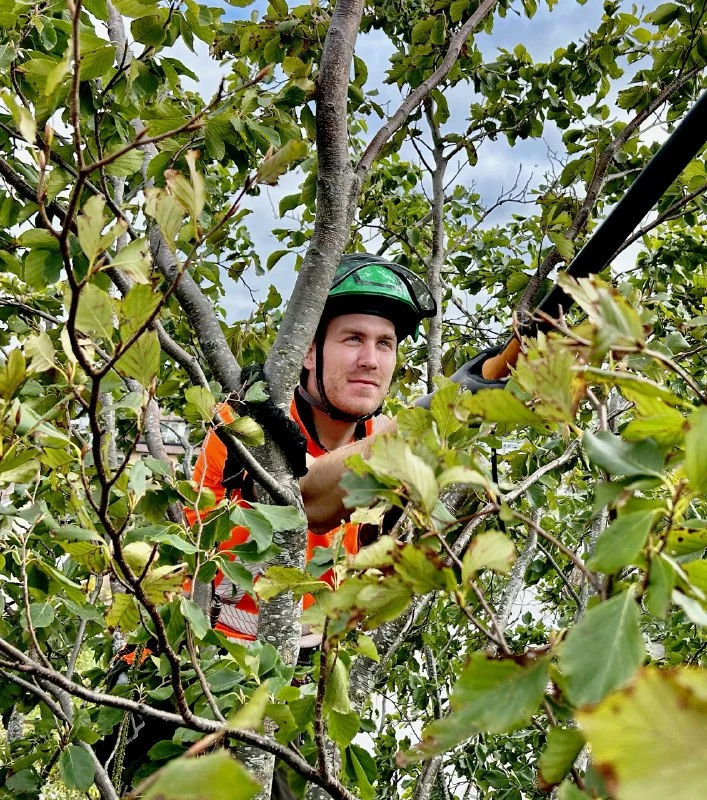Why do trees need pruning?
Trees have been around for 400 million years before us, and many people find it unnecessary to interfere with the natural growth of trees. After all, they did well before the existence of arborists, just as they do well in the forests today.
It sounds like a valid argument, but what may not be obvious is that only 1 seed out of 1 billion grows into a mature tree in nature. In contrast, we want every single tree that we plant in our cities and suburban areas to grow into an old one. Moreover, when trees are moved into our residences, we don’t allow the same conditions as in their natural habitats because they start to interfere with our daily life, safety, and comfort. It becomes urgent to cut down the dead branches that practically pose no danger to anyone in the forest, but if it’s on a busy street with thousands of passengers passing underneath it daily, we consider it a concern that we need to deal with.
Secondly we want to make them more appealing, more aesthetic, and better suited to our environment. As they grow into our buildings, into the electrical infrastructures, covering traffic signs, and blocking street lights we are compelled to cut away the branches causing problems for us.
Mainly these are the reasons for pruning urban and residential trees, but there are some more ancient motivations, namely, we want services from them that they wouldn’t be able to provide on their own, such as more fruits from our orchards, more beauty in our gardens with magnificent flowers, denser foliage to shield us from neighbors - thinner foliage to allow more sunlight, and overall a more regulated form.
That all seems logical and understandable, but could this all benefit the trees?
Dr. Alex Shigo, the most influential pioneer of arboriculture, said: “Proper pruning is one of the best things that can be done for a tree; improper pruning is one of the worst things that can be done to a tree.”
So the key is in knowledge and execution. When we understand tree biology and growth patterns, we can craft trees that are healthier, structurally stronger, and aesthetically pleasing. Pruning that creates near-optimum structure, called structural pruning, results in trees better able to withstand stresses such as ice, snow, and wind storms.
Why don’t trees grow into near-optimum structures on their own?
In a way they do, in nature! Not as single specimens with defect-free, symmetrical structures prepared for all scenarios, but more as the most suitable for the location where the tree lives its life from germination to death. (See more about growth strategies here)
However, when they share living space with humans, they are not allowed to grow naturally. We don’t have the patience to plant seeds and let them grow into saplings like in the wild; instead, we raise them in nurseries, cutting their roots and branches from the very first year, planting them in multiple locations until they reach the expected age to occupy their permanent place. So, without understanding their natural growth strategies and their reactions for different stresses, with improper maintenance we add artificial defects next to the existing natural ones, and we have to keep correcting these defects with pruning or other instruments.
How effective is correcting defects with pruning?
The biggest key factor, besides location and vigor, is the age of the tree. Some defects are easier to correct than others, but experience and scientific studies has shown that proper pruning techniques and strategies are beneficial to the health and life expectancy of trees. To give you an idea, here’s a short list of defects that are wholly or partially correctable with pruning:
Young and medium-aged trees:
• Multiple leaders in codominant stems
• Branch or stem unions with bark inclusions
• Rubbing branches
• Insect or disease-infested branches
• Deformed branches
• Dead or weak branches
• Circling stem-girdling roots
• Clustered branches
• Topped and storm-damaged trees
• Structural root decay
• Dense branch ends
• Water sprouts
Medium-aged and mature trees:
• Branch unions with bark inclusions
• Branches with cracks
• Dead branches
• Branches blocking a view
• Branches hanging over a building
• Branches rubbing against each other
• Long branches with poor taper
• Dense branch ends
• Localized vascular wilt diseases
• Trees topped through sapwood only
• Lion’s-tailed trees
• Leaning trees
• Storm-damaged trees
• Heavy branches with a large diameter
• Unbalanced crown
• Circling roots
Defects that are difficult to correct with pruning in mature trees:
◦ Root loss during construction
◦ Decayed large roots near the trunk
◦ Topped trees
◦ Codominant stems
◦ Trees with extreme dieback
◦ Hollowed or decayed trunks
◦ Heavy top
◦ Crack in the main branch or trunk
◦ Large diameter limbs clustered together
Summary
Historically, pruning was performed in response to the short-term desires of people with less attention to its effects on tree structure, stability, and health. Today, we grow them in nurseries, skipping a significant adaptation period, which leads to multiple problems that we need to keep correcting or preventing. Most of these problems are related to living with people and meeting their desires.
The 8 main objectives of pruning:
1. Reduce the risk of failure.
2. Provide clearance.
3. Reduce shade and wind resistance.
4. Maintain or improve health.
5. Influence flower and fruit production.
6. Improve the view.
7. Enhance aesthetics.
8. Increase lifespan

